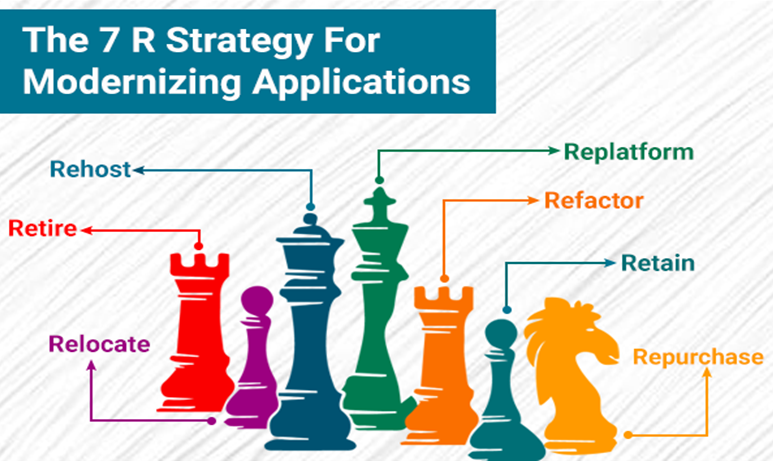
The 7 Rs Of Cloud App Modernization
What precisely does someone mean when they say they wish to update their application for the cloud? From the viewpoint of the user, modernization should result in better user experiences, greater dependability, quicker performance, and, preferably, more regular feature implementations. Varied architects, programmers, and DevOps engineers have varying definitions of what app modernization entails. This is due to the fact that there are multiple technological methods for modernizing apps, and the best option isn't always evident.
A workflow software made in the most recent versions of Java and MySQL, for instance, that is utilized by multiple people, maybe seamlessly moved to a public cloud. This method entails some code rewriting but probably calls for configuration modifications, CI/CD updates, and new test automation runs. However, there is a high possibility that the program will necessitate rewriting completely before operating in the cloud if it was created in Cobol and functions on a mainframe.
However, the answer to this challenge is the 7 Rs of cloud app modernization. The 7 Rs of cloud app modernization are a set of remaining technological choices that fall between a lift-and-shift and a complete rebuild. The top-level modernization choices are accurately represented, although there are some variations across sources.
The 7 R Strategy
Only those firms who consider cloud migration and application modernization to be completely distinct activities can use the 7 R method. With almost little downtime and minimal hazards, these techniques assist enterprises in application modernization. Rehost, Replatform, Retain, Repurchase, Refactor, Relocate, and Retire are some of the techniques. Taking the apt Technical Courses for building a conception on this is vital, prior to handling such things.

Retire
It is more affordable for enterprises to remove apps with dated components and unnecessary features. Moreover, it eliminates the need to start over and allows enterprises to optimize their present codebase and apps with less work. Organizations must determine the ownership of apps once they have finished finding programs for migration and modernization.
Replatform
The replatforming strategy involves making improvements to the company's current cloud platform in order to get concrete advantages. This makes it possible for businesses to maintain the fundamental design of their applications, which cuts down on the time needed to administer database instances.
Businesses may do this by moving their applications to a platform that offers database-as-a-service (DBaaS), like Amazon Relational Database Service (Amazon RDS). Moving their apps to a totally controlled way, like AWS Elastic Beanstalk, is another choice for businesses. Reducing licensing costs while maintaining the integrity of the underlying design, aids organizations in undergoing a beneficial Technical Transformation.
Rehost
This method entails relocating apps without changing them. This is consistent with enterprises' goal of ensuring a quicker changeover. While some businesses choose a manual method to gain a complete understanding of migrating old systems to the cloud, rehosting is frequently automated with the use of technologies.
This tactic, which involves redeploying apps on a virtual setup with the least amount of work possible, is also known as the "lift and shift" of applications. Applications operate without a hitch in the new setting while their data is moved across without being altered. Rehosting occurs significantly more quickly, giving businesses the chance to make improvements in the future with less outlay of cash.
Refactor
With the aid of cloud-native capabilities, the refactor strategy allows businesses to rethink the way apps are created and designed. Key business needs for adding new features, scaling, or improving performance that would be difficult to achieve in the current context, are the reasons that influence application refactoring.
Although implementing this method is expensive, it is still seen to be the most advantageous for businesses with a desirable product-market fit. Refactoring essentially entails changing the design of apps for modernization. Companies favor serverless architectures when modernizing applications to take advantage of better chances. But more time and effort are required for this technique, so it's not without its drawbacks.
Retain
This method prioritizes and stacks applications that require significant reworking but are yet essential to an organization's operations before migration and modernization. Only apps that make commercial sense should be moved by organizations. There will be fewer situations when their applications need to be retained as the strength of their portfolio increases.
Relocate
Without the necessity for brand-new hardware, adjustments to current activities, or rewriting of programs, the relocation method enables enterprises to shift their infrastructure to the cloud system. The interoperability of Virtual machines and the mobility of workloads across on-premises and cloud environments are supported by this technique. The relocation method is designed specifically for situations where businesses move their infrastructure to the VMware Cloud. Technical Courses are available for providing more light on this strategy and its functioning which can help you learn more.
Repurchase
Repurchasing is an approach to software-as-a-service adoption (SaaS). For instance, under the SaaS model, replacing applications that are installed on-premises with an open-source server. Businesses frequently discover cloud-based software that, with the purchase of a license, may substitute their current on-premise systems. Drop and shop is a name usually used for this strategy.
Final Words
Application modernization is a complex and time-consuming procedure. Companies can make a seamless transition to the cloud with the help of a sound plan, the right Corporate Technical Training, and controlled orchestration. The correct cloud service provider partners will enable enterprises to start their smooth journey toward application modernization. Additionally, it will enable them to concentrate their efforts on their mission-critical goals, boosting productivity and efficiency all around.

